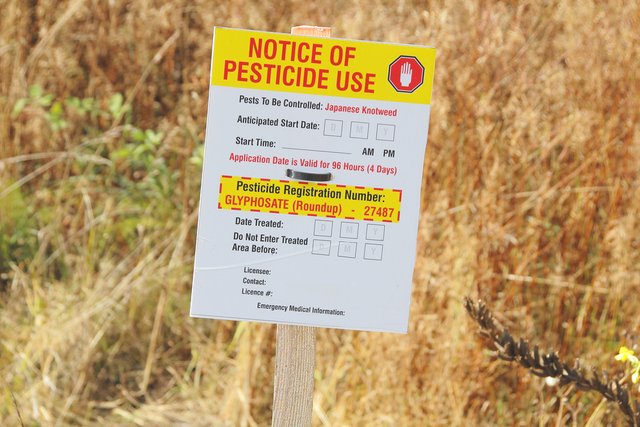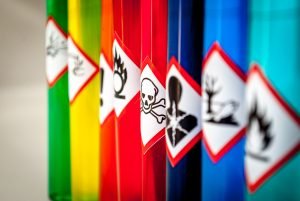This Chemical In Corn, Wheat, Oats & Soy Is WORSE For You Than Gluten!!!

How Glyphosate can CAUSE GLUTEN SENSITIVITY, makes you sick, and is more prevalent than you think!
What Is Glyphosate?
Glyphosate is the active ingredient in the well-known weed-killer, “Roundup”. Glyphosate was patented by Monsanto in the 1970’s, and brought to the consumer market as Roundup in 1974, and became one of the best-selling and most well-known herbicides in the country. It’s use is widespread—not only is it used by homeowners on their lawns, but it’s used on golf courses, cemeteries, parks, and farms. Glyphosate has also become a favorite of farmers using it to kill weeds growing in their crops of wheat, oats, corn and soybeans.
Unfortunately, its use is now spread across the globe and it is heavily used here in the United States, but also Europe and other countries across the globe. Since its early introduction, glyphosate has now become one of the most widely used herbicides around the world.
In 1994, genetically modified crops were created to be “Roundup Ready”, and introduced as being tolerant to this chemical, so its herbicidal action wouldn’t harm the agricultural crops, but would have a greater weed-killing effect on all other plants in the same field. Glyphosate went from being used in between rows of crops to kill just the weeds, to being used to heavily douse GM crops resistant to this toxic chemical.
A recently published paper describes the escalating use of glyphosate: 18.9 billion pounds have been used globally since its introduction in 1974, but a whopping 74 % of all glyphosate sprayed on crops has been applied in just the last 10 years as cultivation of GMO wheat, corn and soybeans expanded in the U.S. and globally.

Glyphosate is Heavily Used too on Non GMO Crops to Speed Up Harvest Times
Farmers often have trouble getting their grain crops like corn, wheat and barley to dry out quickly for harvest, especially in wetter climates. So, for those non GMO crops that are not Roundup Ready, the agri-chemical companies came up with the idea to kill the crop (with glyphosate) one to two weeks before harvest to accelerate the grain dry-out. This pre-harvest use of glyphosate allows farmers to harvest crops as much as two weeks earlier than they normally would.Crop desiccation with glyphosate is now a very common practice, with glyphosate now being sold worldwide by over 40 companies under a variety of trade names. Farmers use massive amounts of glyphosate on non GMO crops such as wheat, oats, soybeans, and other crops right before harvest. Along with wheat and oats, glyphosate is used to desiccate a wide range of other crops including lentils, peas, soybeans, corn, flax, rye, triticale, buckwheat, millet, canola, sugar beets and potatoes. These food products are essentially drenched with glyphosate just a couple weeks prior to harvest, meaning even higher levels of glyphosate that linger once these crops are harvested.

Glyphosate’s Connection to Serious Health Issues
Originally deemed as “safe” and innocuous – as shown by this study done in 2000, published in the Journal of Regulatory Toxicology and Pharmacology, Monsanto, and the U.S. Department of Agriculture, along with the FDA, show an obvious lack of governmental concern.However, more recent studies have surfaced showing glyphosate is not only a dangerous chemical that has invaded our entire food system, but it has been linked to autism, non-Hodgkin lymphoma, serious food allergies (including celiac disease), Parkinson’s, Multiple Sclerosis, Alzheimer’s, obesity, reproductive issues, and liver problems.
Scientists around the world have been reviewing negative research concerning glyphosate, and it has been under even more serious scrutiny since the World Health Organization’s International Agency for Research on Cancer (IARC) classified the herbicide as a “probable human carcinogen” in 2015.
In addition, the IARC also stated, “Glyphosate also caused DNA and chromosomal damage in human cells…and one study in community residents reported increases in blood markers of chromosomal damage (micronuclei) after glyphosate was sprayed nearby.” Seventeen leading global cancer experts from the IARC sparked a firestorm when they classified glyphosate as a class 2A “probable human carcinogen”.
In 2016, the U.S. Environmental Protection Agency (EPA) was set to conduct a risk assessment for glyphosate to determine if future use should be limited, but it was subsequently postponed, due, in part, to intense lobbying by the agrichemical industry.
More than three dozen lawsuits have been filed in California alone against Monsanto by people claiming Roundup gave them non-Hodgkin lymphoma, and both European and U.S. regulators are evaluating the chemical for continued use.
The increasing health issues that are now being tied to glyphosate are most likely caused from the massive increase in its usage, especially due to the escalating practice of grain crop desiccation just prior to the harvest.

Glyphosate Kills Off Beneficial Bacteria in the Gut
This recent study shows glyphosate’s connection to the disruption of key gut bacteria, impairing enzymes that are key to detoxifying the body and causing deficiencies in vitamins A and D3, and impairing the body’s ability to produce bile, a key substance in digestion of fats.Glyphosate also binds with iron, cobalt, molybdenum, copper and other vital minerals in the body, creating serious deficiencies. Other deficiencies in key amino acids have been associated with both celiac disease and glyphosate exposure as well. And, glyphosate is now known to cause extreme disruptions in important beneficial microbes in our digestive tract, allowing overgrowth of harmful pathogens.
Dr. Seneff, a world reknown MIT Phd and scientist, surmises that gluten binds to glyphosate in the digestive system, creating a highly allergenic substance that people react to. This same thing applies to corn, soy, nuts, and peanuts sprayed with glyphosate. The very action of spraying crops with glyphosate creates a highly allergenic substance. Glyphosate also kills off the beneficial bacteria important to the digestion of wheat and other grains. This includes bifido bacteria and lactobaccillus bacteria. Glyphosate disrupts a critical pathway in plants as well, destroying three of their essential amino acids which help our bodies create serotonin. Serotonin deficiencies lead to anxiety, depression, violent behavior, and other mental illnesses. Glyphosate also depletes the body of tyrosine, an essential nutrient needed proper thyroid hormone. As a consequence, thyroid issues are increasing as well—often manifesting as hypothyroid problems, or autoimmune Hashimoto thyroid conditions. Additionally, glyphosate interferes with the activation of vitamin D in the liver by inhibiting the cytochrome P450 enzymes, creating a host of other problems related to vitamin D deficiency.
Says Dr. Seneff,
“…most of the diseases and conditions associated with a Western diet, which include gastrointestinal disorders, obesity, diabetes, heart disease, depression, autism, infertility, cancer and Alzheimer’s disease…can be traced back to a combination of gut dysbiosis, impaired sulfate transport, and suppression of the activity of the various members of the cytochrome P450 (CYP) family of enzymes.” All connected to exposure to glyphosate.
What is especially alarming is that, in April 2016, Anresco – which is a U.S. Federal Drug Administration (FDA) registered lab utilizing one of the most reliable tests for analyzing glyphosate residues — tested some 29 different foods commonly found in grocery stores. Some of the highest glyphosate residue was found in General Mills Cheerios, Honey Nut Cheerios, Stacy’s Pita crackers, Ritz crackers, Lucy’s oatmeal cookies, Kashi dark chocolate soft baked cookies, Little Debbie Oatmeal Cream Pies, and Oreos, and dozens of other so-called ‘healthy’ cereals and snacks. See the full report here.
“Frankly, such a high level of glyphosate contamination found in Cheerios, Doritos, Oreos and Pita Chips are alarming and should be a wake-up call for any parent trying to feed their children safe, healthy and non-toxic food,” Dave Murphy, executive director of Food Democracy Now, said.
The EPA sets a “maximum residue limit” (MRL), also known as a tolerance, for pesticide residues on food like corn and soybeans. MRLs for glyphosate vary depending upon the commodity. As of June, 2017 the FDA has resumed its evaluation of glyphosate in our food supply, after dropping the testing last year.
The list of common crops desiccated with glyphosate prior to harvest is long and alarming. According to the EPA, glyphosate in used in the U.S. on at least 70 different food crops, including grains, spinach, avocados, almonds, walnuts, figs, plums, grapes, kiwi, lemons, grapefruit, pistachios, peanuts, and pomegranates. Check out the full list here. The widespread usage of glyphosate makes it nearly impossible to avoid, and sample testing shows 93% test positive for glyphosate in their bodies.
How to Avoid Glyphosate
No matter how healthy and ‘clean’ we try to eat, this pervasive chemical is extremely difficult to avoid! It is now being used on most all conventional crops, and is so widespread in our environment, its residues are showing up in water run-off, streams, lakes, and rain. It can be carried through the air, so that organic foods now show traces of glyphosate. It’s been found in honey, cereals, meat, drinking water, infant formula, chips, cookies, fruit, and even breast milk!
Things you can do to avoid or minimize your glyphosate exposure:
- Of course, eat organic whenever possible. Especially if you choose to eat grains and legumes, which have some of the highest levels of glyphosate. In fact, research has shown that eating an organic diet for 1 week reduces pesticide exposure in the diet by 90%
- Avoid eating grains at all if you can—they raise blood sugar levels, increase insulin resistance, and cause weight gain when consumed in excess anyway.
- Avoid all processed foods unless they say 100% organic.
- Drink organic wine.
- Eat meat, poultry, eggs, butter and dairy products from 100% grass fed or organically fed animals.
- Buy local whenever possible.
- Eat sulfur rich foods like eggs, organic cheese, onions and garlic. Glyphosate exposure in the body depletes sulfur and also effects sulfate pathways.
- Eat lots of fermented foods and probiotics. Especially important are fermented foods with a live culture of acetobacter. * This includes organic apple cider vinegar, sauerkraut, kimchi, kombucha, cheeses and yogurt.
- Supplement with glutathione and manganese—two nutrients glyphosate depletes.
- Get plenty of sun so your body can make vitamin D, or supplement with D3.
Detoxing Your Body of Glyphosate
Eating a clean, organic diet and being aware of the origins of your food, will go a long way towards reducing the levels of glyphosate and other toxic pesticides in your system.
While Monsanto tries to retain global power over our food supply, we as individuals can take control over what we put in our bodies and the toxins we want to avoid. Let’s make a strong stand against Monsanto by choosing organic and locally grown foods.
Personal note from Catherine
While I have followed all the news articles on glyphosate over the last 5-10 years, I never really thought it had affected me. I eat a mostly low-grain diet, and concentrate on organic plant-based foods and naturally raised meats. However, in the mid 90’s, probably around 1995-96, which was coincidentally right after the introduction of GMO’s and Roundup resistant plants, as well as dramatically increased usage of Roundup, I became very allergic to wheat/gluten, and soon after developed an allergy to corn products, as well as soy. Not long after, I develop an allergy to nuts and peanuts, as well. I am now so sensitive, that it only takes trace amounts of these foods to cause an allergic reaction.
The most telling thing, however, was when I traveled to Peru, Ecuador, and Nepal and was able to eat–without any noticeable reaction–wheat, corn, as well as nuts and peanuts! It was astounding! Most importantly, those countries do not use glyphosate on their crops, as of yet.
Author: Cat Ebeling - original
References
https://detoxproject.org/wp-content/uploads/2016/10/anresco_reports_food_testing_2016.pdf
https://www.alexfergus.com/blog/how-to-protect-yourself-from-glyphosate
https://www.ncbi.nlm.nih.gov/pmc/articles/PMC3945755/
https://enveurope.springeropen.com/articles/10.1186/s12302-016-0070-0
https://www.ncbi.nlm.nih.gov/pmc/articles/PMC3945755/
http://www.glyphosate.eu/glyphosate-basics/history-glyphosate
https://www.ncbi.nlm.nih.gov/pubmed/10854122
http://www.iarc.fr/en/media-centre/iarcnews/pdf/MonographVolume112.pdf
https://www.ecowatch.com/epa-monsanto-glyphosate-cancer-2054307830.html
https://www.ecowatch.com/monsanto-glyphosate-cheerios-2093130379.html
https://www.schmidtlaw.com/roundup-lawsuits-centralized-in-mdl-in-northern-california/
https://articles.mercola.com/sites/articles/archive/2013/06/09/monsanto-roundup-herbicide.aspx